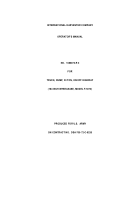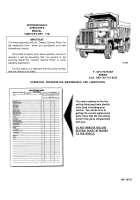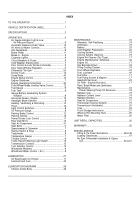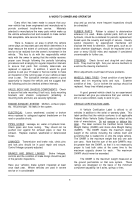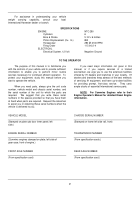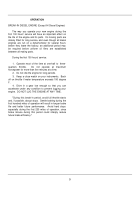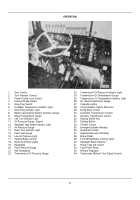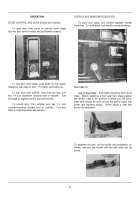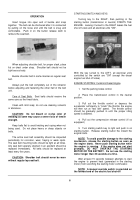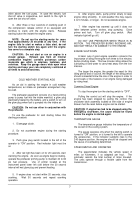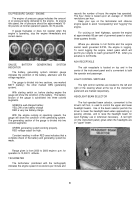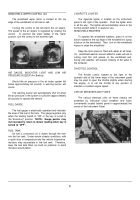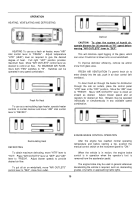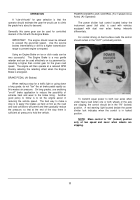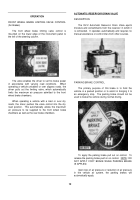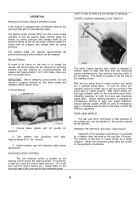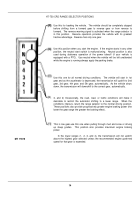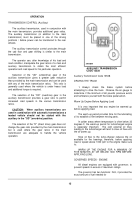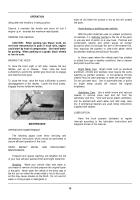TM-5-3805-254-14-P-1 - Page 13 of 590
valve above the fuel pump.
In case the electric fuel
shut-off valve is inoperative, turn switch to the right to
open the fuel shut-off valve.
6.
After three or four seconds of cranking push in
the compression release control (if so equipped) and
continue to crank until the engine starts.
Release
starting button the instant the engine starts.
NOTE:
Do not run the starting motor for more
than approximately 30 seconds at any time.
If the
engine fails to start or makes a false start, do not
turn the starting switch key again until the engine
has come to a complete stop.
CAUTION:
Do not start or run an engine in a
closed garage.
Exhaust gas from all internal
combustion engines' contains poisonous carbon
monoxide gas which is odorless, tasteless, and
colorless.
Keep the garage doors wide open when
starting and keep your cab completely ventilated at
all times to avoid drowsiness.
COLD WEATHER STARTING AIDS
As an aid in starting the engine in cold weather
temperatures, an intake air preheater arrangement may
be used.
The preheater equipment consists of a hand priming
pump to pump fuel into the intake manifold, a glow plug
electrically heated by the battery, and a switch to turn on
the glow plug when fuel is pumped into the intake air.
CAUTION:
Do not use ether in conjunction with
the preheater.
To use the preheater for cold starting follow this
starting procedure:
1.
Disengage clutch.
2.
Do not accelerate engine during the starting
procedure.
3.
Push glow plug switch located to the left of the
operator to "ON" position.
Red indicator light must be
on.
4.
After red light has been on for 20 seconds, start
cranking the engine.
As soon as engine begins rotating,
operate the preheater priming pump to maintain 40 to 60
psi fuel pressure.
Use of primer located at the
instrument panel lower left side before the 20 second
interval will wet glow plug and prevent heating.
5.
If engine does not start within 20 seconds, stop
cranking.
Wait 30 seconds and repeat cranking
operation.
6.
After engine starts, pump primer slowly to keep
engine idling smoothly.
In cold weather this may require
4 to 5 minutes, or longer.
Do not accelerate engine.
7.
After engine has warmed up until it does not
falter between primer strokes, stop pumping.
Close
primer and lock.
Turn off glow plug switch.
(Red
indicator light will go off.)
DO NOT USE PREHEATER WHEN TRUCK IS IN
MOTION.
THE PREHEATER BURNS INCOMING AIR,
AND MAY RESULT IN DAMAGE TO THE ENGINE.
ENGINE SHUTDOWN
A basic rule of good engine operation concerns the
importance of idling the engine from three to five minutes
before shutting down.
This few minutes idling allows the
lubricating oil and water to carry heat away from the iron
masses.
The larger the engine, the greater the need for this
idling period and of course, the length of the idling period
should somewhat follow the size of the engine in order to
avoid seals or like features of an engine being damaged
by rising heat.
Cummins Diesel Engine:
To stop the engine turn the starting switch to "OFF".
Pulling the control out will stop the engine.
If the
engine has been stopped by pulling the control, the
shutdown latch assembly located at inlet side of engine
blower must be reset before engine can be started.
CAUTION:
If engine has had to be stopped using the
emergency shut-down, the cause should be found
before the engine is started again
.
TEMPERATURE GAUGE
The temperature gauge indicates the temperature of
the coolant in the cooling system.
The gauge operates only when the starting switch is
turned to "ON" position, or is turned to the left to operate
the accessories.
If the indicator suddenly rises to the
240 degree position, the engine should be stopped and
the cause of overheating determined.
SPEEDOMETER AND ODOMETER
The speedometer indicates the vehicle speed in
miles (or kilometers, if so adapted) per hour.
The
odometer records the total number of miles traveled.
The units operate through a flexible cable from the
transmission.
7
Back to Top


